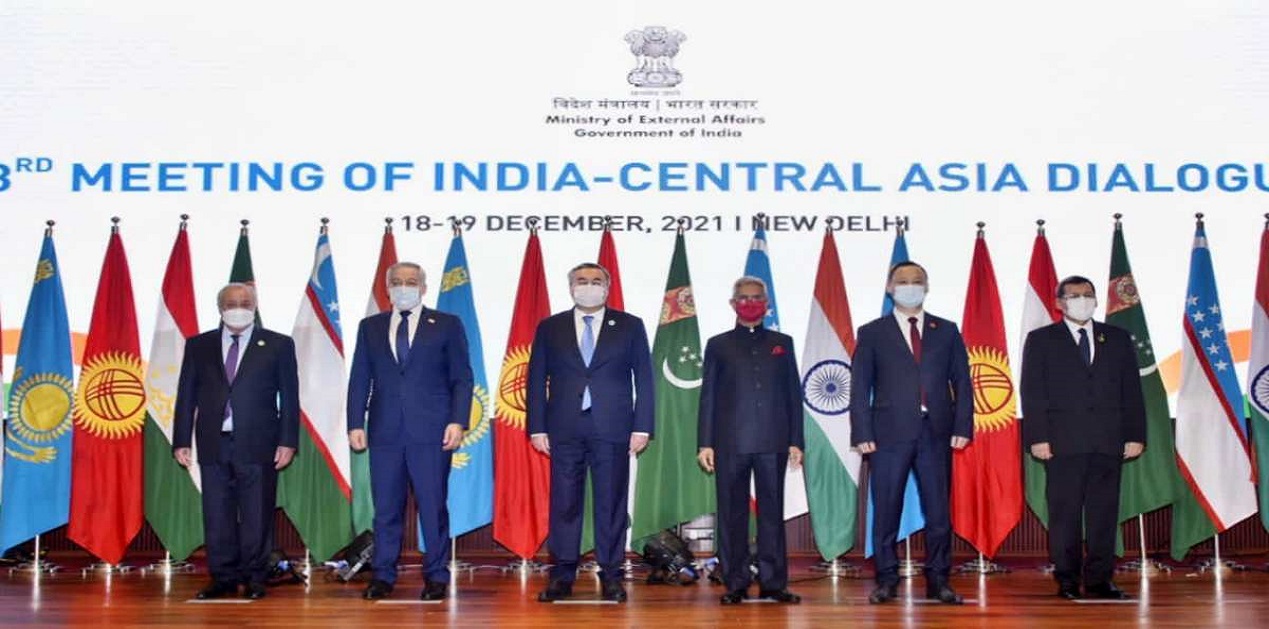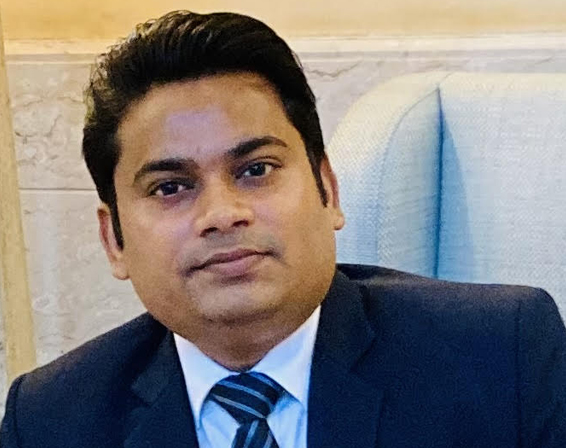Introduction
Central Asia’s geostrategic importance stands increased with the recent developments in Afghanistan. Two major powers, i.e., Russia and China continue to maintain their influence in the region while the US and West still need to work on their strategy in Central Asia. India’s former EAM Smt Sushama Swaraj once stated that India and Central Asia are natural partners and are comfortable working with each other.[1] However, in the post-colonial period, India’s relations with the region have been marginalised. But with concerted efforts, the India-Central relations are on the path of being reinvigorated.
The Third India-Central Asia Dialogue, held in Delhi on December 19, 2021, demonstrated deep mutual trust and cooperation between India and Central Asian republics (CARs).[2] Nonetheless, there is enormous potential between the two regions for enhanced cooperation. The key to successful bilateral cooperation between India and CARs is consistent mutual interactions at many levels. The Indian EAM S. Jaishankar met with the Foreign Ministers of Central Asian countries jointly as well as bilaterally and emphasised the need to focus on the four Cs: commerce, capacity building, connectivity, and contact.[3] These aspects are crucial to strengthen India’s footprint in Central Asia further.
The Central Asian countries and India have strong historical and cultural ties. In recent times, the mutuality of rich cultural history has provided the basis for diplomatic engagement and people-to-people contacts. In addition to this, the bilateral cooperation has accelerated with PM Modi’s visit to the five Central Asian republics in July 2015. India’s permanent membership in the Shanghai Cooperation Organization (SCO) in 2017 has paved the way for increased strategic cooperation between India and the Central Asian republics. Furthermore, India’s outreach to Central Asia has been developed through the India-Central Asia dialogue framework.
This dialogue format has improved the collaborative partnership between the two regions. Many of the proposals outlined at the First Dialogue, which took place on January 13, 2019, in Samarkand (Uzbekistan), have materialised. An India-Central Asia Business Council (ICABC) was established in February 2020 to reinforce trade and investment initiatives between India and CARs.[4] The ICABC has convened two meetings until now and has come up with some fresh ideas to boost India-Central Asia economic ties. In the second meeting held virtually in October 2020, four Joint Working Groups (JWGs) in sectors like Energy (Hydrocarbons & Renewable Energy), Food-Processing, Agro, Textiles, Tourism, Air Corridors, Pharmaceutical, Life-sciences, and Healthcare were proposed to be established.[5] Similarly, other development initiatives like the India-Central Asia Developmental Group’ are in the pipeline.
The Second India-Central Asia Dialogue was virtually held in 2020 as a result of the COVID-19 pandemic. India has issued a one-billion-dollar line of credit (LOC) for priority development projects in energy, healthcare, connectivity, information technology, agriculture, and education, among other areas. Against this backdrop, the third Dialogue has paved the way for bolstering bilateral ties.
Afghanistan: A Common Concern
In August of this year, the Taliban’s takeover of Afghanistan posed severe challenges for both India and Central Asia. Uzbekistan, Tajikistan, and Turkmenistan are three Central Asian countries that share a direct border with Afghanistan and have been affected by the regional developments. They responded to the Taliban regime in dissimilar ways, depending on their domestic circumstances. Similarly, New Delhi maintained its stand on an inclusive government in Afghanistan as a prerequisite to any engagement with the Taliban government. With this, India’s constructive contribution to the development and rehabilitation of Afghanistan has also waned. Eventually, except for Tajikistan, all Central Asian countries have engaged with the Taliban regime, particularly in terms of humanitarian aid. India has continued to avoid interacting with the Taliban directly, but talks with other regional players are progressing.
India convened the Delhi Regional Security Dialogue on Afghanistan in New Delhi on November 10, 2021.[6] The National Security Advisers (NSAs)/Secretaries of Security Councils of Central Asian republics, Russia, and Iran participated in this Dialogue. This was a significant achievement of India’s active diplomacy in Afghanistan. Upon conclusion of this security Dialogue, the ‘Delhi Declaration’ was adopted. All the participants have come to a consensus on ensuring peace and stability in Afghanistan along with countering terrorism and illicit drug trafficking with collective efforts.[7] Also, the NSAs of the participating countries collectively agreed to have an inclusive government in Kabul and reiterated that Afghan land should not be used against any other country.[8]
As predicted, Afghanistan was the major topic of discussion during the Third India-Central Asia Dialogue. The Ministers reaffirmed their commitment to a peaceful, secure, and stable Afghanistan, emphasising the importance of upholding its sovereignty, unity, and territorial integrity. They also decided to continue giving Afghans emergency humanitarian help. The Foreign Ministers also emphasised the importance of UN Security Council Resolution 2593 (2021), which says expressly that Afghan soil cannot be used for terrorists’ shelter, training, planning, or fundraising, and urges for concerted action against all terrorist groups. They agreed to keep working together closely on the Afghan issue.
Coincided with Third India-Central Asia Dialogue, Pakistan hosted an Emergency Summit of Council of Foreign Ministers of the Organisation of Islamic Cooperation (OIC) on December 19, 2021. Pakistan hastily convened the Summit to discuss the humanitarian crisis in Afghanistan. It also demonstrated Islamabad’s diffidence about India’s active diplomacy in Afghanistan. Although the Central Asian Foreign Ministers gave a miss to this Summit as they were scheduled to participate in India-Central Asia Dialogue, the Afghan Foreign Minister Amir Khan Muttaqi participated in this Summit. In the end, OIC Resolution was adopted, which highlighted that the OIC would create a Humanitarian Trust Fund to channel humanitarian aid to Afghanistan under the auspices of the Islamic Development Bank.[9]
Focus On 4Cs
EAM Jaishankar emphasised speeding trade, connectivity, capacity building, and contact in his opening remarks at India-Central Asia Dialogue. The trade and commercial ties between India and Central Asia have remained below the true potential. The lack of direct connectivity has had a massive impact on economic ties. The expansion of India’s Chabahar port in Iran, as well as its inclusion in the International North-South Transport Corridor (INSTC), can alleviate connectivity issues.
Due to their landlocked status, all Central Asian governments have indicated a desire to improve the connectivity between South and Central Asia. The President of Uzbekistan has demonstrated outstanding leadership in promoting regional cooperation in Central Asia. He also appears interested in improving connections between South and Central Asia. In this sense, India-Uzbekistan collaboration in the development of connectivity is critical. India and Central Asia both need to diversify their export portfolios. The continuing deliberation over air corridors may prove to be beneficial.
India’s contribution to Central Asia’s capacity building and human resource development is noteworthy. Thousands of Central Asian students are trained in information technology and communication skills under the Indian Technical and Economic Cooperation (ITEC) Programme. This helps boost India’s image and develop people-to-people contact. Jaishankar has proposed enhancing the number of ITEC seats available and conducting specialized training programmes in areas like cyber security, counter-terrorism, energy, and space. The Dialogue also aimed to foster collaboration among specialised national institutions in areas like finance, renewable energy, information, digital and other innovative technologies, and green energy.
Central Asia offers India’s pharmaceutical industry a potential market. There is a great opportunity in building pharmaceutical manufacturing units due to a lack of connectivity. Furthermore, collaboration in the healthcare industry, particularly in medical tourism, appears to be promising. The India-Central Asia Dialogue also emphasised the importance of leveraging India and Central Asia’s strong civilizational and cultural legacies to strengthen bilateral ties. It was also highlighted that coordination in education might be accelerated. Universities in India, such as Sharda and Amity, have already established themselves in Uzbekistan, which may be expanded to other Central Asian countries.
Conclusion
Remarkably, regular interactions and discussions at various levels have aided in the strengthening of this relationship. India’s ties with Central Asia still have a huge amount of potential. It’s also worth noting that the two regions’ shared interests will continue to bridge gaps and foster greater collaboration in previously unexplored areas. The India-Central Asia Dialogue has been profitable in the developing relationship between India and Central Asia. All the presidents of Central Asian republics have been invited to participate as chief guests in India’s republic day parade in 2022. Also, in January 2022, New Delhi is set to host an India-Central Asia leaders’ Summit. This will help to boost India’s outreach to the Eurasian region and be a game-changer as the region navigates through the great power struggle.
References
[1] ‘Press Statement by EAM after First India-Central Asia Dialogue’ Ministry of External Affairs, Government of India. January 13, 2019. https://www.mea.gov.in/Speeches-Statements.htm?dtl/30907/Press_Statement_by_EAM_After_1st_IndiaCentral_Asia_Dialogue
[2] ‘Joint Statement of the 3rd meeting of the India-Central Asia Dialogue’, Ministry of External Affairs Government of India. December 19, 2021. http://www.mea.gov.in/bilateral-documents.htm?dtl/34705/Joint+Statement+of+the+3rd+meeting+of+the+IndiaCentral+Asia+Dialogue
[3] ‘India will take ties to next level, with focus on commerce, connectivity: Jaishankar,’ Economic times, 19 December 2021. https://auto.economictimes.indiatimes.com/news/industry/india-will-take-ties-to-next-level-with-focus-on-commerce-connectivity-jaishankar/88373191
[4]Dr Pravesh Kumar Gupta, ‘India-Central Asia Business Council: Reinvigorating India-Central Asia Economic Engagement’, VIF Article. February 10 , 2020. https://www.vifindia.org/2020/february/10/india-central-asia-business-council
[5] ‘India & Five Central Asian Countries to Focus on Developing Air Corridors, Promote Collaboration in Healthcare sector: 2nd India-Central Asia Business Council meeting’ FICCI, 28, October 2020. https://ficci.in/pressrelease-page.asp?nid=3944
[6]The Delhi Regional Security Dialogue on Afghanistan (November 10, 2021)’, Ministry of External Affairs Government of India. 10 November 2021. https://www.mea.gov.in/press-releases.htm?dtl/34489/The_Delhi_Regional_Security_Dialogue_on_Afghanistan_November_10_2021
[7] ‘Delhi Declaration on Afghanistan’, Ministry of External Affairs, Government of India. 10 November 2021. https://mea.gov.in/bilateral-documents.htm?dtl/34491/Delhi_Declaration_on_Afghanistan
[8]Ibid.
[9] ‘OIC nations pledge fund to prevent Afghanistan economic collapse’, Al JAjeera, 19 December 2021. https://www.aljazeera.com/news/2021/12/19/oic-nations-pledge-fund-to-prevent-afghanistan-economic-collapse
(The paper is the author’s individual scholastic articulation. The author certifies that the article/paper is original in content, unpublished and it has not been submitted for publication/web upload elsewhere, and that the facts and figures quoted are duly referenced, as needed, and are believed to be correct). (The paper does not necessarily represent the organisational stance... More >>
Image Source: https://images.indianexpress.com/2021/12/S-Jaishankar-1.jpg











Post new comment